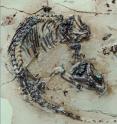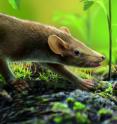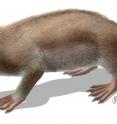Prehistoric mammal likely suffered from hair disease
Related images
(click to enlarge)
An international team of researchers, together with participation from the University of Bonn, has investigated a stunning fossil finding from the Cretaceous period. The 125-million-year-old mouse- to rat-sized mammal is preserved so well that even detailed analyses of its fur are possible. An astounding finding: The animal may have suffered from a fungal infection of the hair which also strikes mammals nowadays. The scientists are publishing their results in the journal Nature. The researchers were startled by one other detail: The hairs on the back of the Cretaceous mammal are fused into small spines. They resemble those of a hedgehog but are much smaller. The small mammal owes its name, Spinolestes (from spinosus, Latin for "spiny"), to them. This is the first time that paleontologists were able to identify spines in a fossil from the Mesozoic era.
The skin on the animal's back was also partially covered with small, horny scutes. "We are familiar with these characteristics in modern spiny mice from Africa and Asia Minor," explains Prof. Dr. Thomas Martin from the Steinmann Institute of Geology, Mineralogy and Paleontology of the University of Bonn. "If a predator grabs them by the back, the spines detach from the skin. The mouse can escape and the attacker is left with nothing more than a mouthful of spines." It is possible that these structures served a similar purpose in the case of Spinolestes.
Robust back
Spinolestes is only very distantly related to mice. "We are not able to classify the finding in any of the groups of mammals alive today," Prof. Martin stresses. "It displays characteristics which we also find in today's mammals. However, these are not signs of relatedness but rather they developed independently - throughout the course of evolution, they have been 'invented' many times."
This also applies to a special feature of the spine: The individual vertebrae have appendages through which they are interlocked with one another. As a result, the Spinolestes' back was extraordinarily strong - but the reason why is open to speculation. "Similar structures are found today in armadillos and anteaters but also in the African hero shrew," says Martin. "For instance, the hero shrew uses its strong back to break off palm fronds from the trunk of the tree. In this way, it can reach insect larvae living between the attachment points of the fronds and the trunk."
The finding comes from the Las Hoyas fossil site in Spain, which has primarily been known up to now for its well-preserved bird and reptile fossils. However, three years ago, an excavation team under the direction of the paleontologist Angela Buscalioni (Autónoma University, Madrid) encountered the fossilized skeleton of a small unknown mammal there. They brought the discovery to Bonn where the bones and tissue were separated from the limestone using a special procedure.
The scientists are particularly amazed by the excellent condition of the fossil, especially the fossilized fur. "This is completely unparalleled to date," Prof. Martin is pleased to report. Together with his colleagues from Spain, France, and the United States he examined the hairs in detail. Among other things, they also found changes which suggest a fungal disease of the fur. It is thus possible that the prehistoric mammals suffered from diseases similar to those of their modern descendants.
In any case, the findings strikingly show one of these diseases, says Prof. Martin: "One hundred twenty-five million years ago, Spinolestes was very well adapted to its ecological niche - through horny scutes and spines on its back as well as through its reinforced spine." The fossil thus joins the ranks of an entire range of newer findings. "We have to revise our thinking," emphasizes Martin. "Mammals were indeed very small during the time of the dinosaurs. But they were certainly not primitive."
Source: University of Bonn
Articles on the same topic
- 125-million-year-old mammal fossil reveals the early evolution of hair and spinesWed, 14 Oct 2015, 18:53:07 UTC
Other sources
- Cretaceous Fur Ball: Ancient Mammal With Spiky Hair Discoveredfrom Live ScienceThu, 15 Oct 2015, 12:00:26 UTC
- 'Cute furball' fossil unearthedfrom BBC News: Science & NatureThu, 15 Oct 2015, 1:30:07 UTC
- Scientists find earliest evidence of mammalian hairfrom UPIWed, 14 Oct 2015, 21:30:18 UTC
- 125-million-year-old mammal fossil reveals the early evolution of hair and spinesfrom Science DailyWed, 14 Oct 2015, 18:50:13 UTC
- 125-Million-Year-Old Mammal Fossil Reveals the Early Evolution of Hair and Spinesfrom Newswise - ScinewsWed, 14 Oct 2015, 18:00:06 UTC
- Breathtaking fossil of tiny mammal preserves fur and internal organsfrom Science NOWWed, 14 Oct 2015, 17:30:08 UTC
- Prehistoric mammal likely suffered from hair diseasefrom PhysorgWed, 14 Oct 2015, 17:00:07 UTC


